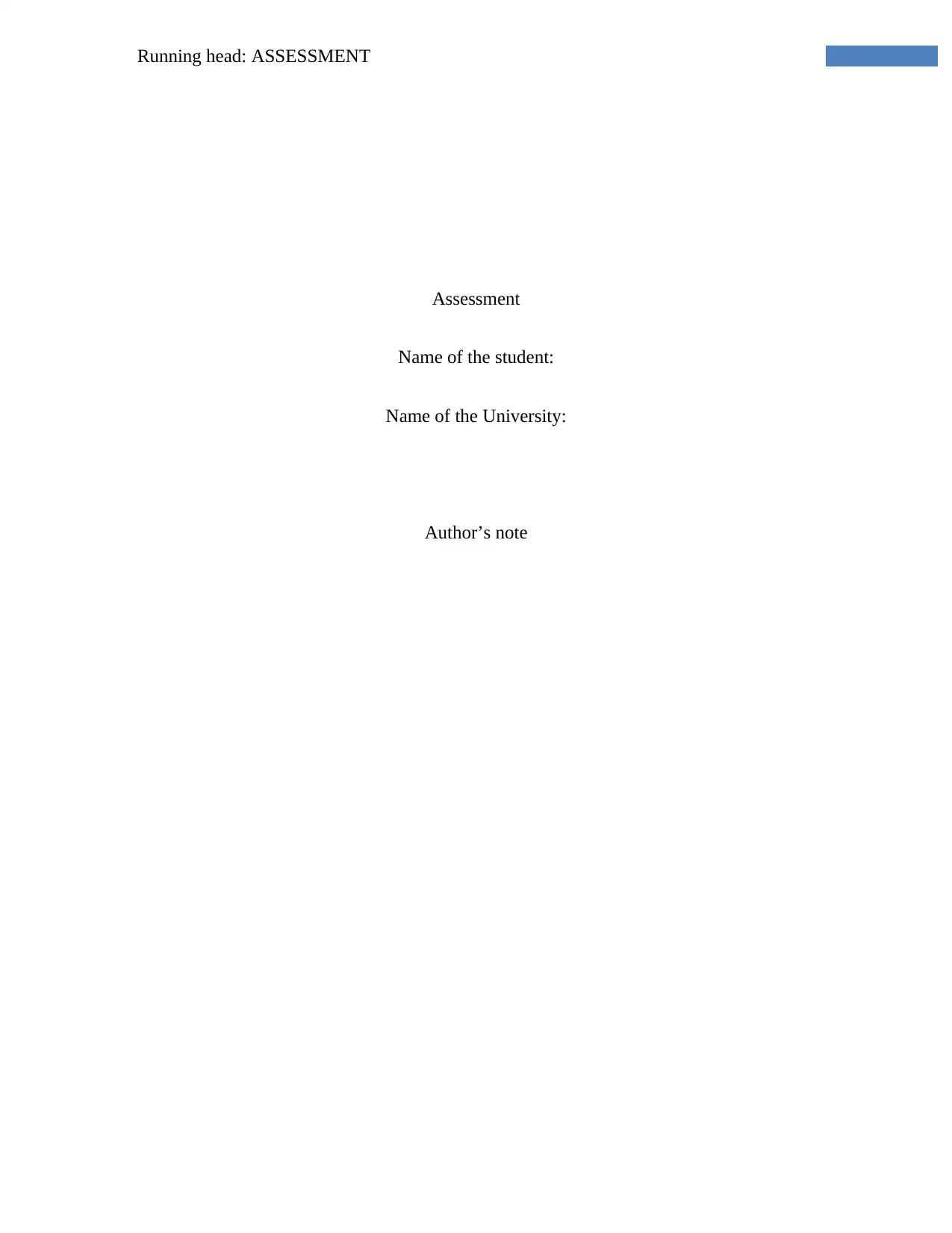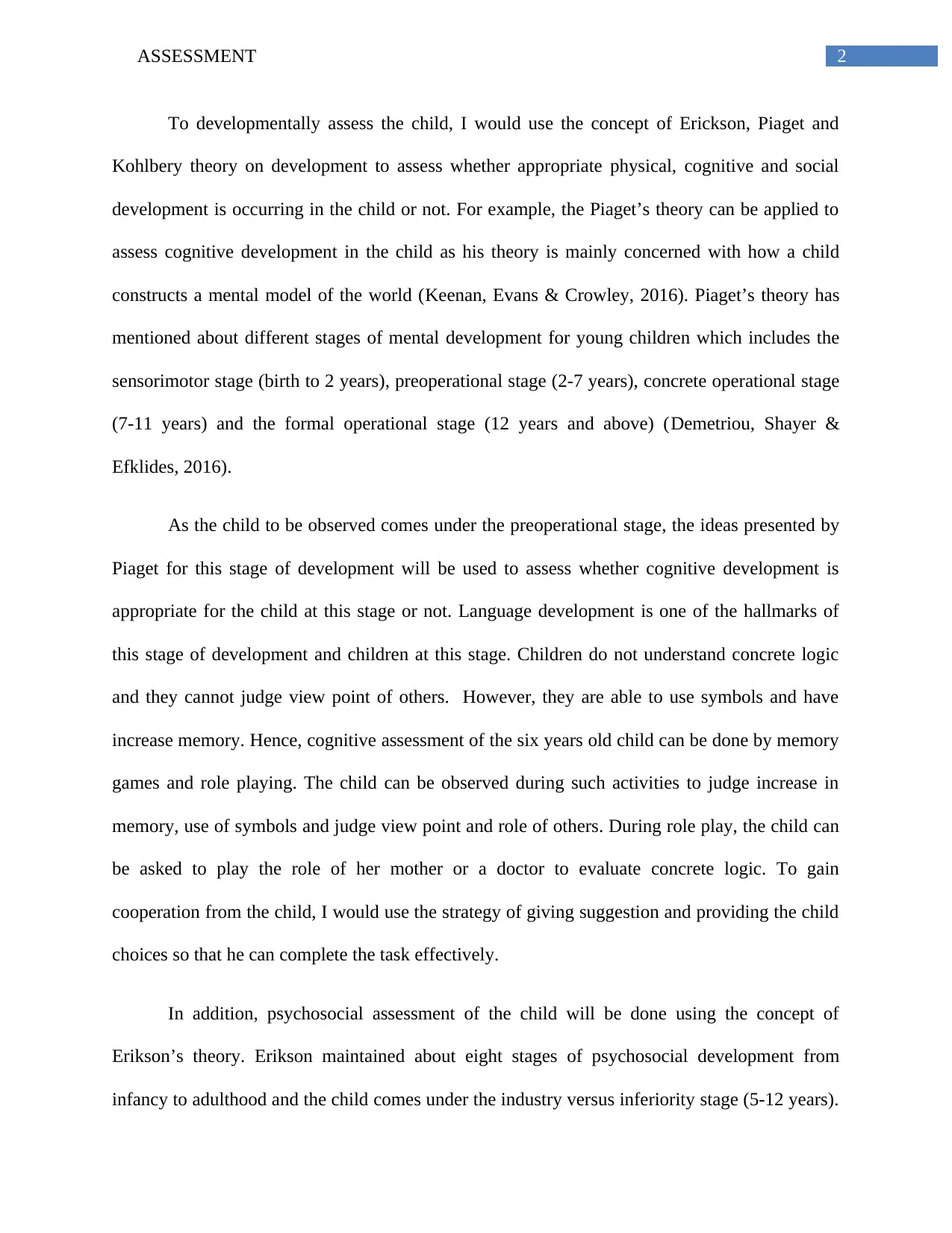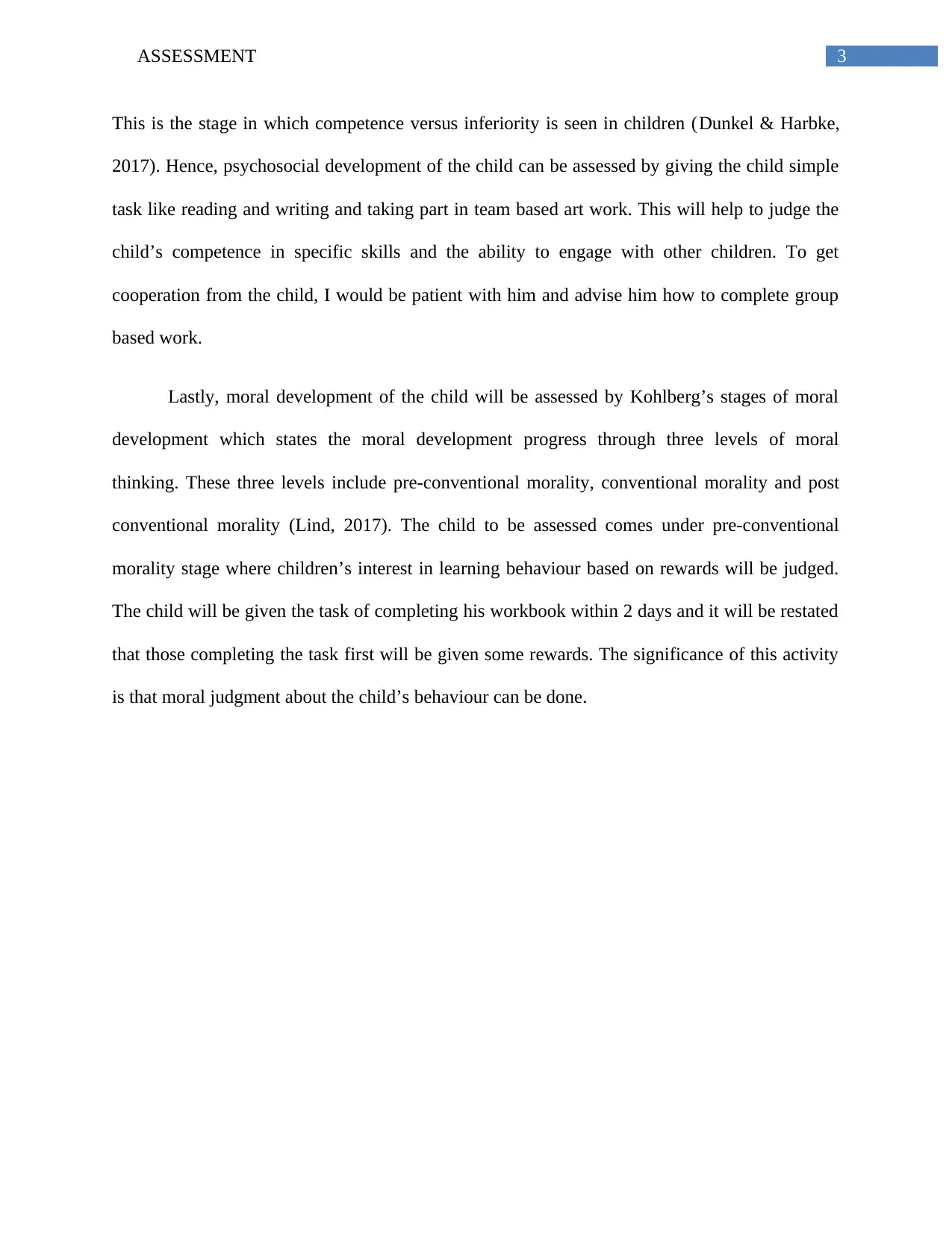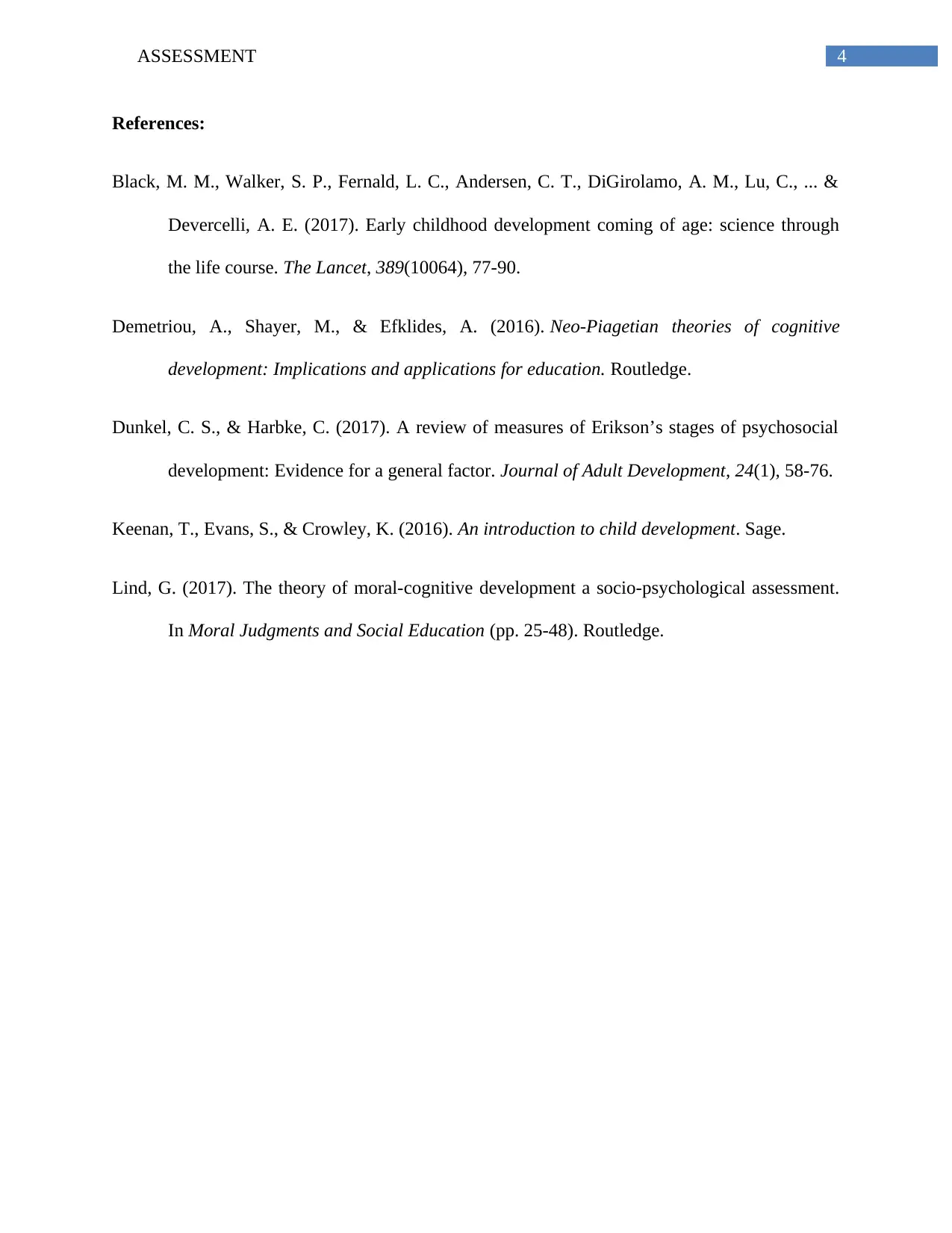Psychology Report: Child Development Assessment Using Theories
VerifiedAdded on 2022/11/13
|5
|1110
|314
Report
AI Summary
This report focuses on the assessment of child development, specifically targeting school-aged children (6-12 years). It explores various assessment methods, including observation, portfolio development, and role-playing, while considering cognitive, psychosocial, and moral development. The report applies theories from Piaget, Erikson, and Kohlberg to evaluate a six-year-old child's developmental stage, focusing on the preoperational stage for cognitive development, the industry versus inferiority stage for psychosocial development, and the pre-conventional morality stage. The assessment methods are tailored to match the child's age and developmental stage. The report emphasizes the importance of understanding a child’s behaviors and experiences in these different stages of development. It also provides practical strategies to gain cooperation from the child during assessment activities.

Running head: ASSESSMENT
Assessment
Name of the student:
Name of the University:
Author’s note
Assessment
Name of the student:
Name of the University:
Author’s note
Paraphrase This Document
Need a fresh take? Get an instant paraphrase of this document with our AI Paraphraser

1ASSESSMENT
Types of assessments among school-aged children
School age children include children between the age of 6 to 12 years who are ready for
more independence. However, this children lack awareness about making good choices and
struggle with many logical thoughts. Different types of physical assessments that can be
completed in school age children which includes observation method, developing portfolios,
integrating parents in assessment and using role play to conduct assessment. The main role of
child observation is to observe and record important facets of development in the child and give
scores to the child based on different domains. In addition, portfolios play a role in promoting
physical collection of student’s work to assess their learning and developmental progress (Black
et al., 2017). For each of the assessment methods, the content of the activities will be modified
by matching child’s age with developmental stages in each areas such as cognitive, psychosocial
and moral development.
Developmental stage of a child:
The child to be assessed is a 6 years old child and the child is at middle childhood
developmental stage. Specific developmental stage is a period when behaviours and experiences
are common for children of that age group. A six year child comes under the stage of three-seven
year old, which is a period of high creativity. Children at this stage needs to distinguish between
what is real and what is imaginary. Children in this stage have different form of physical
development, emotional, social and cognitive development. Hence, it is necessary to evaluate the
developmental progress and needs of the child at this stage.
Development assessment of the child
Types of assessments among school-aged children
School age children include children between the age of 6 to 12 years who are ready for
more independence. However, this children lack awareness about making good choices and
struggle with many logical thoughts. Different types of physical assessments that can be
completed in school age children which includes observation method, developing portfolios,
integrating parents in assessment and using role play to conduct assessment. The main role of
child observation is to observe and record important facets of development in the child and give
scores to the child based on different domains. In addition, portfolios play a role in promoting
physical collection of student’s work to assess their learning and developmental progress (Black
et al., 2017). For each of the assessment methods, the content of the activities will be modified
by matching child’s age with developmental stages in each areas such as cognitive, psychosocial
and moral development.
Developmental stage of a child:
The child to be assessed is a 6 years old child and the child is at middle childhood
developmental stage. Specific developmental stage is a period when behaviours and experiences
are common for children of that age group. A six year child comes under the stage of three-seven
year old, which is a period of high creativity. Children at this stage needs to distinguish between
what is real and what is imaginary. Children in this stage have different form of physical
development, emotional, social and cognitive development. Hence, it is necessary to evaluate the
developmental progress and needs of the child at this stage.
Development assessment of the child

2ASSESSMENT
To developmentally assess the child, I would use the concept of Erickson, Piaget and
Kohlbery theory on development to assess whether appropriate physical, cognitive and social
development is occurring in the child or not. For example, the Piaget’s theory can be applied to
assess cognitive development in the child as his theory is mainly concerned with how a child
constructs a mental model of the world (Keenan, Evans & Crowley, 2016). Piaget’s theory has
mentioned about different stages of mental development for young children which includes the
sensorimotor stage (birth to 2 years), preoperational stage (2-7 years), concrete operational stage
(7-11 years) and the formal operational stage (12 years and above) (Demetriou, Shayer &
Efklides, 2016).
As the child to be observed comes under the preoperational stage, the ideas presented by
Piaget for this stage of development will be used to assess whether cognitive development is
appropriate for the child at this stage or not. Language development is one of the hallmarks of
this stage of development and children at this stage. Children do not understand concrete logic
and they cannot judge view point of others. However, they are able to use symbols and have
increase memory. Hence, cognitive assessment of the six years old child can be done by memory
games and role playing. The child can be observed during such activities to judge increase in
memory, use of symbols and judge view point and role of others. During role play, the child can
be asked to play the role of her mother or a doctor to evaluate concrete logic. To gain
cooperation from the child, I would use the strategy of giving suggestion and providing the child
choices so that he can complete the task effectively.
In addition, psychosocial assessment of the child will be done using the concept of
Erikson’s theory. Erikson maintained about eight stages of psychosocial development from
infancy to adulthood and the child comes under the industry versus inferiority stage (5-12 years).
To developmentally assess the child, I would use the concept of Erickson, Piaget and
Kohlbery theory on development to assess whether appropriate physical, cognitive and social
development is occurring in the child or not. For example, the Piaget’s theory can be applied to
assess cognitive development in the child as his theory is mainly concerned with how a child
constructs a mental model of the world (Keenan, Evans & Crowley, 2016). Piaget’s theory has
mentioned about different stages of mental development for young children which includes the
sensorimotor stage (birth to 2 years), preoperational stage (2-7 years), concrete operational stage
(7-11 years) and the formal operational stage (12 years and above) (Demetriou, Shayer &
Efklides, 2016).
As the child to be observed comes under the preoperational stage, the ideas presented by
Piaget for this stage of development will be used to assess whether cognitive development is
appropriate for the child at this stage or not. Language development is one of the hallmarks of
this stage of development and children at this stage. Children do not understand concrete logic
and they cannot judge view point of others. However, they are able to use symbols and have
increase memory. Hence, cognitive assessment of the six years old child can be done by memory
games and role playing. The child can be observed during such activities to judge increase in
memory, use of symbols and judge view point and role of others. During role play, the child can
be asked to play the role of her mother or a doctor to evaluate concrete logic. To gain
cooperation from the child, I would use the strategy of giving suggestion and providing the child
choices so that he can complete the task effectively.
In addition, psychosocial assessment of the child will be done using the concept of
Erikson’s theory. Erikson maintained about eight stages of psychosocial development from
infancy to adulthood and the child comes under the industry versus inferiority stage (5-12 years).
⊘ This is a preview!⊘
Do you want full access?
Subscribe today to unlock all pages.

Trusted by 1+ million students worldwide

3ASSESSMENT
This is the stage in which competence versus inferiority is seen in children (Dunkel & Harbke,
2017). Hence, psychosocial development of the child can be assessed by giving the child simple
task like reading and writing and taking part in team based art work. This will help to judge the
child’s competence in specific skills and the ability to engage with other children. To get
cooperation from the child, I would be patient with him and advise him how to complete group
based work.
Lastly, moral development of the child will be assessed by Kohlberg’s stages of moral
development which states the moral development progress through three levels of moral
thinking. These three levels include pre-conventional morality, conventional morality and post
conventional morality (Lind, 2017). The child to be assessed comes under pre-conventional
morality stage where children’s interest in learning behaviour based on rewards will be judged.
The child will be given the task of completing his workbook within 2 days and it will be restated
that those completing the task first will be given some rewards. The significance of this activity
is that moral judgment about the child’s behaviour can be done.
This is the stage in which competence versus inferiority is seen in children (Dunkel & Harbke,
2017). Hence, psychosocial development of the child can be assessed by giving the child simple
task like reading and writing and taking part in team based art work. This will help to judge the
child’s competence in specific skills and the ability to engage with other children. To get
cooperation from the child, I would be patient with him and advise him how to complete group
based work.
Lastly, moral development of the child will be assessed by Kohlberg’s stages of moral
development which states the moral development progress through three levels of moral
thinking. These three levels include pre-conventional morality, conventional morality and post
conventional morality (Lind, 2017). The child to be assessed comes under pre-conventional
morality stage where children’s interest in learning behaviour based on rewards will be judged.
The child will be given the task of completing his workbook within 2 days and it will be restated
that those completing the task first will be given some rewards. The significance of this activity
is that moral judgment about the child’s behaviour can be done.
Paraphrase This Document
Need a fresh take? Get an instant paraphrase of this document with our AI Paraphraser

4ASSESSMENT
References:
Black, M. M., Walker, S. P., Fernald, L. C., Andersen, C. T., DiGirolamo, A. M., Lu, C., ... &
Devercelli, A. E. (2017). Early childhood development coming of age: science through
the life course. The Lancet, 389(10064), 77-90.
Demetriou, A., Shayer, M., & Efklides, A. (2016). Neo-Piagetian theories of cognitive
development: Implications and applications for education. Routledge.
Dunkel, C. S., & Harbke, C. (2017). A review of measures of Erikson’s stages of psychosocial
development: Evidence for a general factor. Journal of Adult Development, 24(1), 58-76.
Keenan, T., Evans, S., & Crowley, K. (2016). An introduction to child development. Sage.
Lind, G. (2017). The theory of moral-cognitive development a socio-psychological assessment.
In Moral Judgments and Social Education (pp. 25-48). Routledge.
References:
Black, M. M., Walker, S. P., Fernald, L. C., Andersen, C. T., DiGirolamo, A. M., Lu, C., ... &
Devercelli, A. E. (2017). Early childhood development coming of age: science through
the life course. The Lancet, 389(10064), 77-90.
Demetriou, A., Shayer, M., & Efklides, A. (2016). Neo-Piagetian theories of cognitive
development: Implications and applications for education. Routledge.
Dunkel, C. S., & Harbke, C. (2017). A review of measures of Erikson’s stages of psychosocial
development: Evidence for a general factor. Journal of Adult Development, 24(1), 58-76.
Keenan, T., Evans, S., & Crowley, K. (2016). An introduction to child development. Sage.
Lind, G. (2017). The theory of moral-cognitive development a socio-psychological assessment.
In Moral Judgments and Social Education (pp. 25-48). Routledge.
1 out of 5
Related Documents
Your All-in-One AI-Powered Toolkit for Academic Success.
+13062052269
info@desklib.com
Available 24*7 on WhatsApp / Email
![[object Object]](/_next/static/media/star-bottom.7253800d.svg)
Unlock your academic potential
Copyright © 2020–2025 A2Z Services. All Rights Reserved. Developed and managed by ZUCOL.





